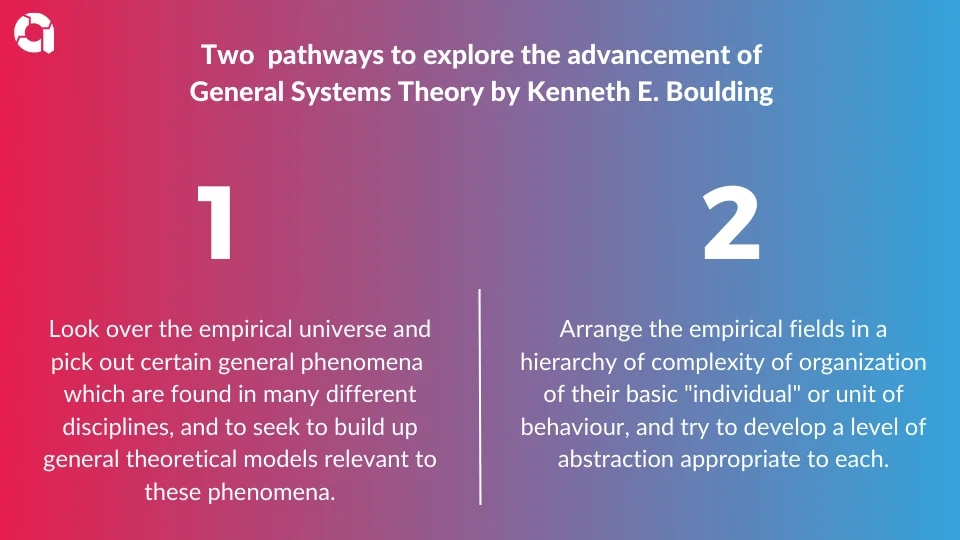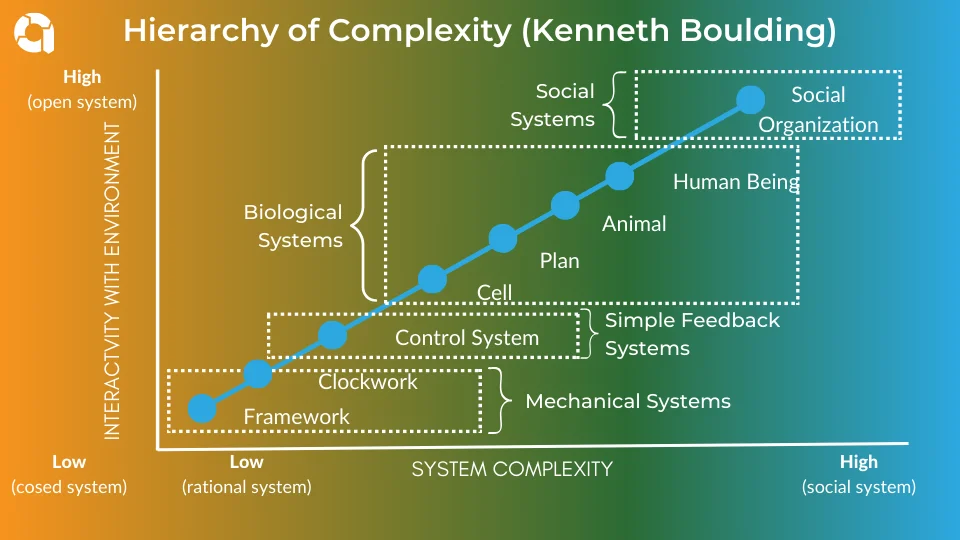Introducing the boulding hierarchy of complexity
The concept of complexity has been a subject of great interest and debate in various fields, including mathematics, physics, biology, and economics. When it comes to understanding complex systems, it is often helpful to have certain frameworks that can help us analyze and categorize such systems. One such framework is the “Boulding hierarchy of complexity,” which was developed by the renowned economist and systems thinker Kenneth Boulding in the mid-twentieth century. This hierarchy provides a way of understanding different types of systems and how they are interrelated, from the simplest to the most complex (Boulding 1956).
In this blog post, we will delve into the boulding hierarchy of complexity and explore its relevance to our understanding of modern-day problems.
Exploring pathways for advancing the general systems theory
Boulding offered two intriguing pathways to explore for the advancement of the General Systems Theory (GST) as shown in figure 1 (Boulding 1956).
- The first approach is to study the world around us, find things that are common in many different disciplines and then seek to develop models that can be relevant to all types of systems.
- The second approach is to arrange the observation in a hierarchy of complexity of organization of their basic “individual” or unit of behaviour and to try to develop a level of abstraction appropriate to each.

The first approach requires identifying common patterns and phenomena that occur across various disciplines, such as the interactions of populations, individual behaviours, growth, and communication and information processes. By studying these commonalities, Boulding believed that it could eventually lead to the advancement of a general theory of dynamics and interaction that could be applied to all systems. However, boulding also recognized that developing such a theory would be a challenging and time-consuming process and believed it would take a considerable amount of time to achieve this goal.
A second approach involves organizing theoretical systems and constructs in a hierarchy of complexity that corresponds to the complexity of the “individuals” in different empirical fields. This approach is more methodical than the first and leads to a “system of systems.”
This approach stresses the importance of “emergence,” the new properties that arise at higher levels of complexity.
In pursuit of his preferred approach (Jackson 2019), Boulding produces nine levels of theoretical discourse listed in table 1.
Explaining the nine levels of the boulding hierarchy
| Level | Description | Characteristics | Examples | Discipline |
|---|---|---|---|---|
| 1 | Structure and Framework | Static, Special Pattern | Bridge, Mountain, Crystal, Atom | Descriptive Elements of all Disciplines |
| 2 | Clockworks | Predeterminated Motion | Clocks, Machines, Solar System | Physical, Astronomy, Engineering |
| 3 | Control Mechanisms | Closed-loop Control | Thermostate, Homeostasis | Cybernetics |
| 4 | Open Systems | Life, Self-maintaining, Capacity for Learning | Flames, Cells | Theory of Metabolism |
| 5 | Lower Organism | Growth Systems, Society of Cells, Functional parts | Plants | Botany |
| 6 | Animals | Self-aware Systems | Birds and Beasts | Zoology |
| 7 | People | Self-conciousness, Knowledge, Langugae | Human Beings | Biolology, Phychology |
| 8 | Sociocultural Systems | Roles, Communication, Values, Socially Constructed, Relationship of Power, | Families, Clubs, Communities | History, Sociology, Anthropology |
| 9 | Transcendental systems | Inescapable Uknownables | God | Philosophy, Religion |
Structure and framework:
At the base of the boulding hierarchy of complexity are “structure and frameworks,” which are the most basic and simple type of system. Frameworks can be thought of as the building blocks for more complex systems, and they provide the basic structure for many things we encounter in daily life. An example of a framework might be a set of principles or laws that govern a particular field, such as the laws of physics or the rules of accounting. While frameworks may seem simplistic, they are essential for building more complex systems on top of them.
Clockworks:
The second level of the boulding hierarchy is “clockworks.” Clockworks are systems that operate according to a set of pre-determined rules and are highly predictable. An example of a clockwork system would be a mechanical watch, which operates according to the laws of physics and is entirely predictable in its movements.
Control mechanism:
At level 3, control mechanisms that display closed-loop control are studied through cybernetics. A thermostat is an example of this kind of system.
Open systems:
Open systems that display structural self-maintenance are studied through metabolism theories at level 4. A biological cell is an instance of a level 4 system.
Lower organism:
Level 5 involves lower organisms that possess functional parts, blueprint growth, and reproduction. These systems are studied through botany, with plants being an example.
Animal:
Level 6 consists of animals that possess a brain to guide their behaviour, can learn, and are studied through zoology. An elephant is an example of a level 6 system.
People:
At level 7, human beings are studied through biology and psychology, as they possess self-consciousness, use symbolic language, and know that they know.
Sociocultural systems:
Sociocultural systems are studied through history, sociology, anthropology, and behavioural science at level 8. They are characterized by roles, communications, and the transmission of values, with nations being an example of level 8 systems.
Transcendental systems:
The highest level, level 9, encompasses transcendental systems that cannot be captured by any scientific discipline. This level includes “inescapable unknowables,” with the idea of god being an example (Jackson 2019).

Embark on Transformation
Start the Systems Thinking learning journey and become an expert in navigating intricate landscapes.
Complexity and hierarchy
As we move up the levels in the hierarchy, the level of complexity increases as shown in figure 2, making it more difficult for observers to make predictions. The first two levels of the hierarchy are made up of mechanical systems, while the third level comprises control systems that function through basic feedback. Levels 4-7 pertain to biological systems, ranging from cells to plants, animals, and humans. Level 8 includes social systems, and the final level, level 9, is described as transcendent.

Boulding’s work suggests that each level of the hierarchy has emergent properties that cannot be fully understood using the theoretical concepts employed at lower levels. As a result, new disciplines such as biology, psychology, anthropology, and sociology are required to study more complex system levels.
This highlights the danger of reductionism, which involves analyzing an empirical phenomenon using theoretical concepts from a lower level of complexity.
Boulding contends that General Systems Theory (GST) cannot simply extend the traditional scientific approach to higher levels of complexity. Instead, a different kind of knowledge is necessary at these levels, which requires an approach that is more in tune with phenomenology, pragmatism, and interpretive social science. Therefore, it is essential to avoid treating organizations as if they were machines or organisms, as this oversimplifies their complex nature (Jackson 2019).
Conclusion
The boulding hierarchy of complexity provides a useful framework for understanding the different types of systems that exist in the world and how they are interrelated. By analyzing systems at each level of the hierarchy and recognizing the emergent properties that appear at each level, we can gain a better understanding of their unique characteristics and the factors that influence their behaviour.
The hierarchy of complexity offers practitioners a unique way to understand the complexities of systems and to recognize emergent properties at every level. By gaining a deeper understanding of hierarchical complexity, practitioners can improve the accuracy and effectiveness of their models while addressing major challenges.
This framework is especially relevant today, as we face increasingly complex problems that require various systems thinking approaches to tackle problems in diverse domains. Whether we are trying to solve problems related to climate change, politics, or economic systems, the boulding hierarchy of complexity can help us draw deeper insights and make more informed decisions.


